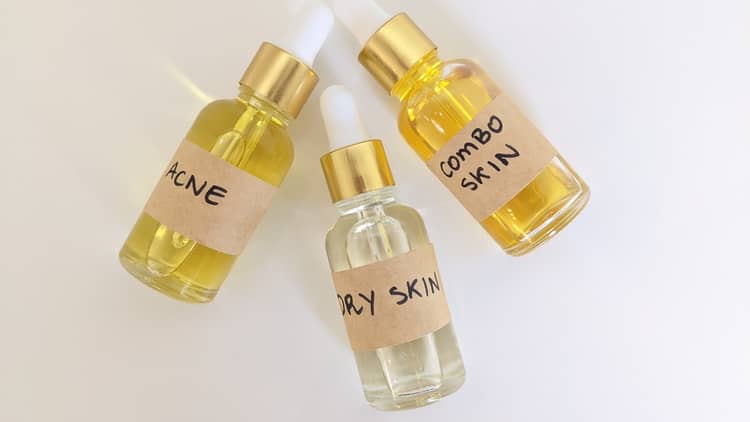
If you’re thinking about making your own face oils, but you have no idea where to start, then you’re in for a treat! In this article you’re getting access to multiple DIY facial oil recipes for different skin types, as well as tips on things to consider when making your own blends (such as how to use essential oils, herb-infused oils and much more).
So, without further delay, let’s dive into the recipes!
Note: this post contains affiliate links and I earn a commission (at no additional cost to you) if you use them to make a purchase.
DIY FACE OIL RECIPES
NOTE: Each of the recipes below are suitable for a 1 ounce glass bottle.
1. For dry skin
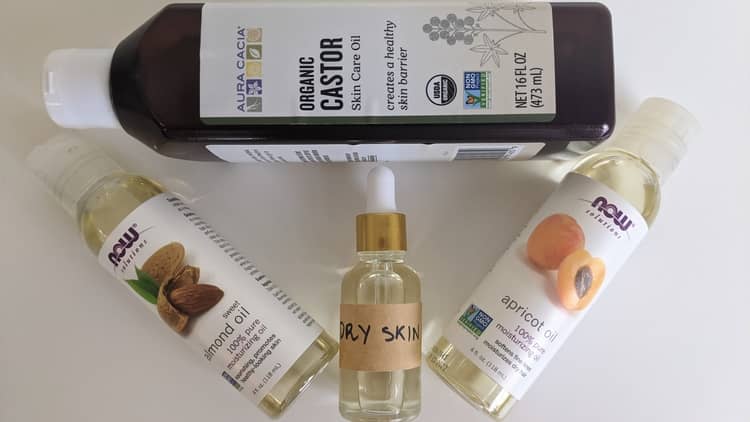
1 Tbsp almond oil
1 Tbsp + 1 tsp apricot kernel oil
1/2 – 1 tsp castor oil
2. For dry sensitive skin
2 tsp jojoba oil
2 tsp grapeseed oil
2 tsp calendula oil
3. For combination skin
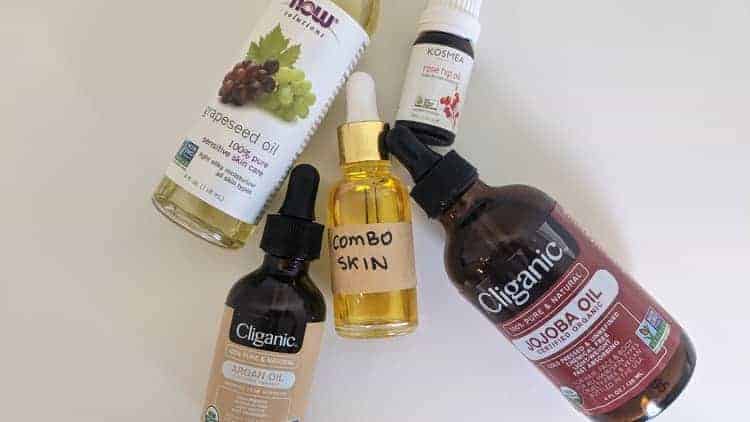
2 tsp jojoba oil
2 tsp argan oil
1 tsp rosehip oil
1 tsp grapeseed oil
4. For rosacea
1 Tbsp jojoba oil
2 tsp neem oil
2 tsp argan oil
5. For oily skin
1 Tbsp + 1 tsp grapeseed oil
1 Tbsp jojoba oil
6. For Mature or Aging (anti-wrinkle)
1 Tbsp rosehip oil
2 tsp apricot oil
2 tsp argan oil
7. For acne
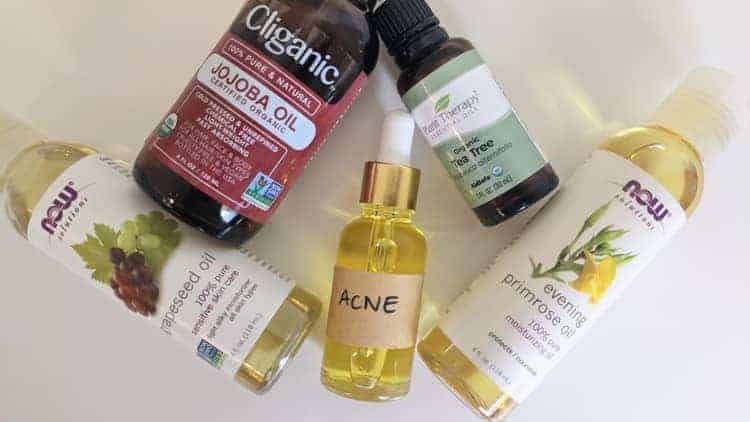
1 Tbsp jojoba oil
1 Tbsp evening primrose oil
2 tsp grapeseed oil
Tea tree oil or geranium oil (optional) – see the section below for more about essential oils and how much to use.
HOW TO MAKE HOMEMADE FACIAL OIL
1. Choose the best carrier oil for your skin type
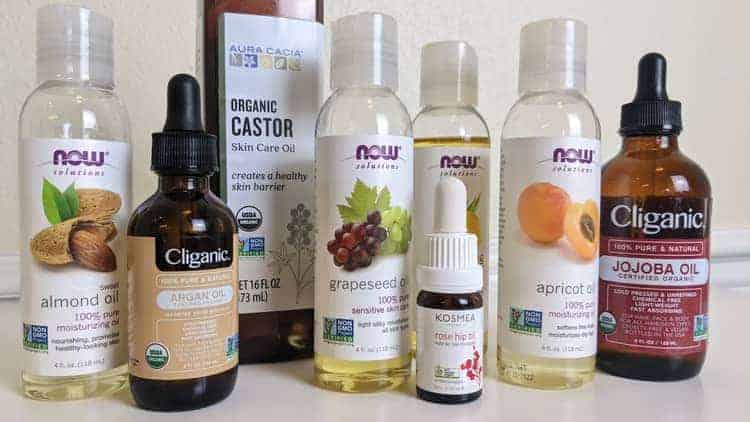
When choosing carrier oils, there are three factors to consider:
- Absorption rate: fast-absorbing oils are preferable for face oils because they leave little to no residue on the skin. That said, oils that are slower to absorb also have many benefits for the skin. It’s simply a matter of finding the right balance of both for your particular skin.
- Fatty acid composition: In general, oils that are richer in oleic acid are heavy and good for dry skin. On the other hand, oils that are richer in linoleic acid tend to be lightweight and are better for oily skin. That said, healthy skin is about having a good balance of all fatty acids. So, mix and match oils for the best results.
- Comedogenic rating: even though there is some debate about how valid the comedogenic rating is, it’s still something that many of us have become accustomed to following. So, feel free to use it as a guide when choosing oils for your blend. But remember that no one oil is comedogenic for 100% of people.
Now, here are some of the best seed carrier oils to use in facial oil recipes (for details about the benefits of these oils, read these guides on the best carrier oils for sensitive skin and this one about non-greasy carrier oils).
Almond oil – GET IT HERE.
- Medium absorption rate.
- Oleic acid: 57.54% – 73.94% ; Linoleic acid: 19.32% – 35.18% (source).
Apricot kernel oil – GET IT HERE.
- Fast absorption rate.
- Oleic acid: 62.1 – 70.6% ; Linoleic acid: 21 – 27.8% (source).
Argan oil – GET IT HERE.
- Fast absorption rate.
- Oleic acid: 44.3 – 52.53% ; Linoleic acid: 24.24 – 36.8% (source).
Castor oil – GET IT HERE.
- Very slow absorption rate.
- Ricinoleic acid: 85 – 90% ; Oleic acid: 3 – 4% ; Linoleic acid: 4 – 5% (source).
- Note that ricinoleic acid has humectant properties, meaning that it draws moisture to the skin.
Evening primrose oil – GET IT HERE.
- Medium absorption rate.
- Oleic acid: 6.93% ; Linoleic acid: 70 – 74% (source).
Grapeseed oil – GET IT HERE.
Jojoba oil – GET IT HERE.
- Fast to medium absorption.
- Oleic acid: 8.3% ; Eicosenoic acid: 73.4%. Note that eicosenoic acid is one of the key components of sebum (source).
Neem oil – GET IT HERE.
- Very slow absorption rate.
- Oleic acid: 25 – 58% ; linoleic 6 – 17% (source).
- Notable for having a broad spectrum of dermatological uses, particularly for inflamed skin. However, it does have a very strong scent. Not for the faint of heart 🙂
Rosehip oil – GET 10% DISCOUNT OFF ROSEHIP OIL HERE
- Fast absorption.
- Oleic acid: 19.5% ; Linoleic acid: 54.05% (source).
2. Use essential oils wisely
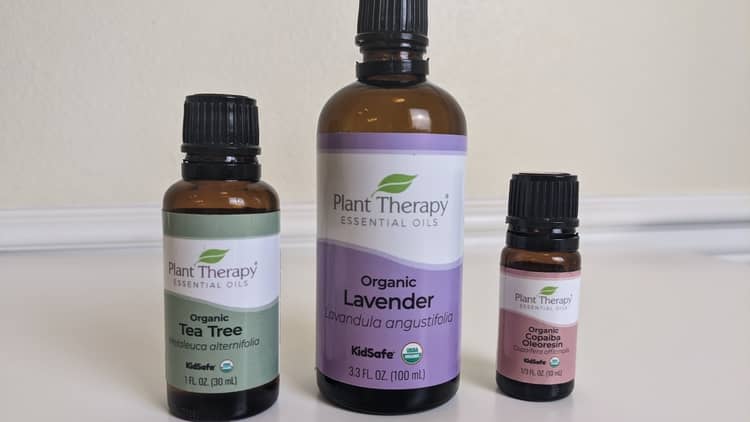
Even though essential oils have become very common in skincare, my personal preference is to use them only when there’s an actual need (as opposed to using them to simply make a product smell nice).
Now, as far as how much to use, experts suggest a maximum dilution of 1.5% is best for daily cosmetics. This equates to 13 drops of essential oil for every ounce of carrier oil. For the delicate eye area, it’s best to go lower (0.5%).
That said, there’s also a study showing that a 5% dilution of tea tree oil – in a gel formulation – is effective for acne (source). For a deeper dive into dilutions, you can read this guide on how to dilute essential oils for the skin.
So, with this in mind, here are some essentials that have been studied and their potential benefits for the skin (3, 4)
- Clary sage: helpful for cell renewal, acne, wrinkles, inflammation, blisters, oily skin. Also regulates sebum. GET CLARY SAGE OIL HERE.
- Copaiba oil: contains beta-caryophyllene which interacts with cannabinoid receptors in skin. As a result of interacting with cannabinoid receptors, copaiba can soothe inflammation. It’s also considered one of the safest essential oils to use on the skin. GET COPAIBA OIL HERE.
- Frankincense oil: powerful anti-inflammatory; may help with wrinkles; one study performed with human skin cells showed that it could help with wound healing and reduce the formation of scars. There are many varieties of frankincense and while you can use any one that you have, some experts suggest frankincense frereana and frankincense carterri for skin. GET FRANKINCENSE FREREANA HERE and FRANKINCENSE CARTERRI HERE.
- Geranium oil: helpful for acne, rosacea, psoriasis, eczema, cracked skin, oily skin, mature and dry skin, burns. Also regulates sebum and fight infections (bacterial, fungal and viral). You can use either Egyptian or Bourbon Geranium. GET EGYPTIAN GERANIUM HERE and BOURBON GERANIUM HERE.
- Helichrysum oil: helpful for acne, rosacea, psoriasis, eczema, scars, bacterial infections and wounds. Also reputed to be a powerful anti-aging oil (it’s also called immortelle, which is French for immortal or everlasting). GET HELICHRYSUM HERE.
- Lavender oil: acne, rosacea, inflammation, psoriasis, eczema, scarring, sunburn, infections (bacterial, fungal and viral). Also has antiseptic properties. GET LAVENDER HERE.
- Rose otto oil (from the rosa damascena variety aka bulgarian rose): helps with dry skin, eczema, bacterial infections, inflammation and wounds. Also acts as a toner. GET ROSE OTTO OIL HERE.
- Peppermint oil: helpful for acne, oily skin, dermatitis, inflammation, sunburn. Also has antiseptic properties. GET PEPPERMINT OIL HERE.
- Tea tree oil: helpful for acne, oily skin, blisters, burns, cuts, rashes, wounds, viral and bacterial infections. Also has antiseptic and anti-inflammatory properties. GET TEA TREE OIL HERE.
3. Use an herb-infused oil for the skin
Unlike essential oils – which contain only the volatile oils of a plant, but no nutrients – herb-infused oils are incredibly soothing and beneficial for all skin types because they contain many essential nutrients.
Now, if you’re not familiar with herb-infused oils, these are simply herbs (such as lavender or comfrey) that have been soaked in a base oil (such as almond, grapeseed, olive, etc.). As the herb soaks in oil, many of its therapeutic properties are pulled into the oil.
The end result is a therapeutic oil that combines the benefits of the base oil with the properties of the herb. The herb-infused oil can be applied directly to the skin or mixed with other oils to create face oils, salves, balms, soap and much more.
Some skin-friendly herbs that are great for infusing in oils include:
- Lavender: antimicrobial and anti-inflammatory; soothes sunburn, rashes, bug bites and inflamed skin.
- Calendula: antifungal, anti-inflammatory and antibacterial. Has naturally hydrating properties and is frequently used as a natural remedy for inflamed and sensitive skin. GET CALENDULA OIL HERE.
- Chamomile: antimicrobial and anti-inflammatory; soothes redness, itching; calms sensitive skin.
In addition to the above, other plants that can be infused in oil include rose, nettle and plantain. You can make these infused oils yourself (this tutorial from Herbal Academy is great) or you can buy them ready-made.
When purchasing a ready-made oil, pay close attention to the base oil that is used. Almond, sunflower, olive and soy oil are some of the oils that companies often use.
4. Store appropriately
To protect your face oil, it’s best to store it in a dark-colored glass bottle (I used clear bottles just so you can see what the blends look like). GET YOUR 1 OZ STORAGE BOTTLES HERE.
In addition keep these storage and preservation tips in mind:
- rosehip has a pretty short shelf life once opened (about 6 months). So, if you use it any blends, consider storing them in the fridge to maintain freshness for as long as possible.
- you can use a preservative in your face oil if you want. However, it’s not a must since there are no water-based ingredients in the recipes (water is prime breeding ground for bacteria).
CONCLUSION
Making your own face oil gives you full control over the ingredients, consistency, scent and basically, every aspect of the oil.
Use the recipes in this article to get started. And of course, have fun experimenting with other oils and coming up with your own unique mix!
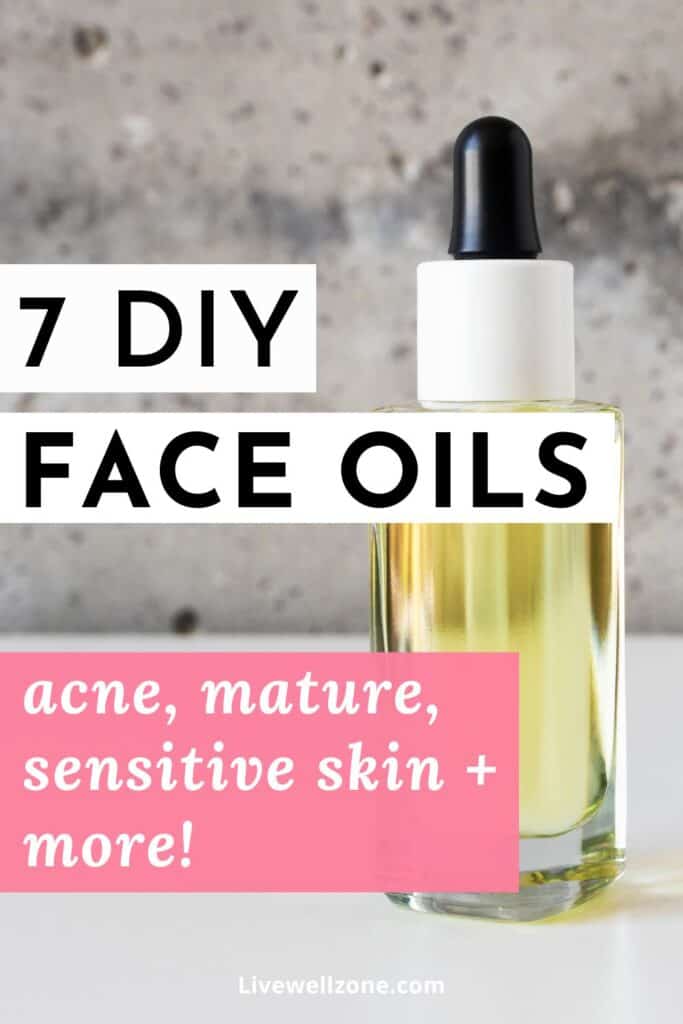
You Might Also Enjoy:
Best Oils for Acne Prone Skin: Carrier, Essential and Cleansing Oils You Shouldn’t Ignore
How to Make Stretch Mark Cream and Oil: Step-by-Step Guide
Grapeseed Oil vs Jojoba Oil for Skin: Which Is Better & How to Use
What Kind Of Coconut Oil Is Best As A Carrier Oil for Skin? Fractionated vs Unrefined vs Refined
Evening Primrose Oil vs Rosehip Oil: Benefits, Differences, How to Use & Best Brands
Rosehip Oil vs Jojoba Oil for Face (And Body): Which is Better and How To Use
What To Mix (And Not) With Rosehip Oil For Face – The Ultimate Guide
The Difference Between Rosehip Oil and Rosehip Seed Oil: Benefits, Which To Use and How to Use
What To Mix With Shea Butter for Skin and Hair: Tips and Recipes
11 Best Oils for Under Eyes (to Improve Wrinkles, Puffiness, Dark Circles and Dryness)
Carrier Oils By Skin Type: How to Choose and Simple List for Beginners

